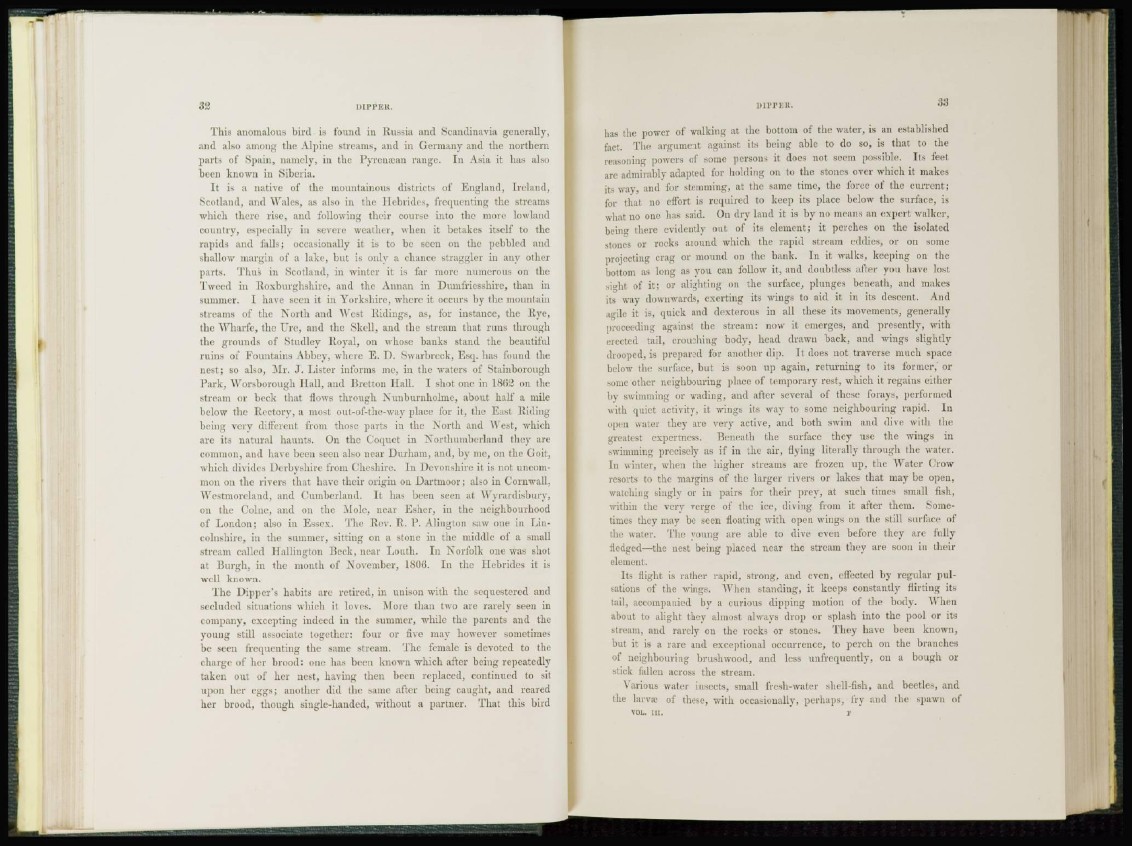
DIPPER.
This anomalous bird is found in Russia and Scandinavia generally,
and also among the Alpine streams, and in Germany and the northern
parts of Spain, namely, in the Pyrenajan range. In Asia it has also
been known in Siberia.
I t is a native of the mountainous districts of England, Ireland,
Scotland, and Wales, as also in the Hebrides, frequenting the streams
which there rise, and following their course into the more lowland
country, especially in severe weather, when it betakes itself to the
rapids and Jails; occasionally it is to be seen on the pebbled and
shallow margin of a lake, but is only a chance straggler in any other
parts. Thus in Scotland, in winter it is far more numerous on the
Tweed in Roxburghshire, and the Annan in Dumfriesshire, than in
summer. I have seen it in Yorkshire, where it occurs by the mountain
streams of the North and West Ridings, as, for instance, the Rye,
the AVharfe, the t i r e , and the Skell, and the stream that runs through
the grounds of Studloy Royal, on whose banks stand the beautiful
ruins of Fountains Abbeys where E. D . Swarbreck, Esq. has found the
nest; so also, Mr, J. Lister informs me, in the waters of Stainborough
P a r k , Worsborough Hall, and Bretton Hall. I shot one in 1862 on the
stream or beck that Hows through \ unburuholme, about half a mile
below the Rectory, a most out-of-the-way place for it, the East Riding
being very different from those parts in the North and "West, which
are its natural haunts. On the Coquet in Northumberland they are
common, and have been seen also near Durham, and, by me, on the Goit,
which divides Derbyshire from Cheshire. In Devonshire it is not uncommon
on the rivers that have their origin on Dartmoor; also in Cornwall,
Westmoreland, and Cumberland. It has been seen at Wyrardisbury,
on the Colne, and on the Mole, near Esher, in the neighbourhood
of London; also in Essex. The Rev. R. P. Alington saw one in Lincolnshire,
in the summer, sitting on a stone in the middle of a small
stream called Harrington Beck, near Louth. In Norfolk one was shot
at Burgh, in the month of November, 1806. In the Hebrides it is
well known.
The Dipper's habits are retired, in unison with the sequestered and
secluded situations which it loves. More than two are rarely seen in
company, excepting indeed in the summer, while the parents and the
young still associate together: four or five may however sometimes
be seen frequenting the same stream. The female is devoted to the
charge of her brood: one has been known which after being repeatedly
taken out of her nest, having then been replaced, continued to sit
upon her eggs; another did the same after being caught, and reared
her brood, though single-handed, without a partner. That this bird
DIPP ]•: R. m
has the power of walking at the bottom of the water, is an established
fact. The argument against its being able to do so, is that to the
reasoning powers of some persons it docs not seem possible. Its feet
are admirably adapted for holding on to the stones over which it makes
its way, and for stemming, at the same time, the force of the current;
for that no effort is required to keep its place below the surface, is
what no one has said. On dry land it is by no means an expert walker,
being there evidently out of its clement; it perches on the isolated
stoucs or rocks around which the rapid stream eddies, or on some
projecting crag or mound on the bank. In it walks, keeping on the
bottom as long as you can follow it, and doubtless after you have lost
sight of it; or alighting on the surface, plunges beneath, and makes
its way downwards, exerting its wings to aid it in its descent. And
agile it is, quick and dexterous in all these its movements, generally
proceeding against the stream: now it emerges, and presently, with
erected tail, crouehing body, head drawn back, and wings slightly
drooped, is prepared for another dip. It does not traverse much space
below the surface, but is soon up again, returning to its former, or
some other neighbouring place of temporary rest, wdiich it regaius either
by swimming or wading, and after several of these forays, performed
with quiet activity, it wings its way to some neighbouring rapid. In
open water they are very active, and both swim and dive with the
greatest expertness. Beneath the surface they use the wings in
swimming precisely as if in the air, flying literally through the water.
In winter, when the higher streams are frozen up, the Water Crow
resorts to the margins of the larger rivers or lakes that may be open,
watching singly or in pairs for their prey, at such times small fish,
within the very verge of the ice, diving from it after them. Sometimes
they may be seen floating with open wings on the still surface of
the water. The young are able to dive even before they are fully
fledged—the nest being placed near the stream they are soon in their
element.
Its flight is rather rapid, strong, and even, effected by regular pulsations
of the wings. When standing, it keeps constantly flirting its
tail, accompanied by a curious dipping motion of the body. When
about to alight they almost always drop or splash into the pool or its
stream, and rarely on the rocks or stones. They have been known,
but it is a rare and exceptional occurrence, to perch on the branches
of neighbouring brushwood, and less unfreqiieutly, on a bough or
stick fallen across the stream.
Various water insects, small fresh-water shell-fish, and beetles, and
the larva; of these, with occasionally, perhaps, fry ami the spawn of
VOL. in. y